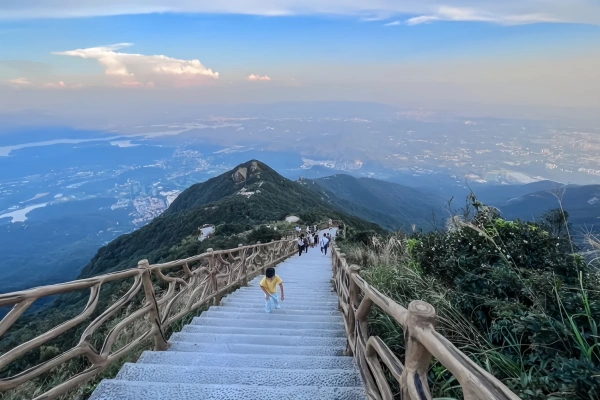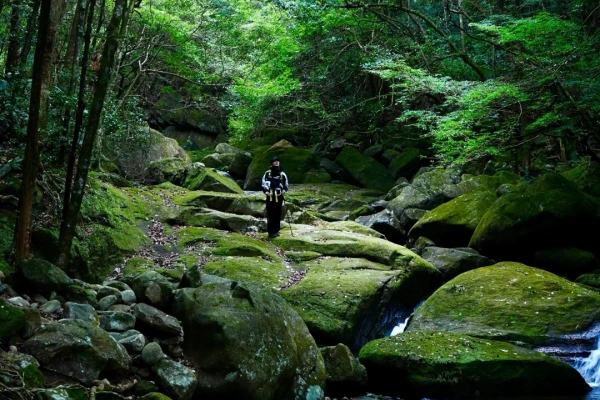Luofu Mountain Scenic Area
Historical Background
Eastern Han Dynasty (25–220 AD): Emerged as a Taoist pilgrimage site, with legends linking it to the immortal Ge Hong.
Tang Dynasty (618–907): Developed into a major Taoist center, with temples like "Chongxu Ancient Temple" constructed.
Song Dynasty (960–1279): Renowned poets and scholars, including Su Shi, praised its beauty in literary works.
1980s–Present: Declared a national scenic area and geopark, undergoing extensive ecological preservation projects.
Geological Wonders
The mountain’s unique landscape, shaped over 140 million years, features:
Granite Peaks: Towering cliffs and rock formations like "Flying Cloud Peak" and "Lion Platform."
waterfalls: The "Baiheli Falls" plunges 120 meters, creating a misty spectacle.
Caves: Explore the "Huanglong Cave," home to ancient Taoist inscriptions and stalactites.

Cultural and Religious Sites
Chongxu Ancient Temple: A 1,600-year-old Taoist temple complex with intricate carvings and incense-filled halls.
Huanglong Observatory: A historic site where astronomers once studied the stars, now a museum of Taoist cosmology.
Crane Cave: Linked to Taoist legends of immortals riding cranes, with stone carvings dating to the Ming Dynasty.NaturalScenery
Bamboo Forests: Walk through dense bamboo groves, their leaves rustling in the breeze.
Pine Valleys: Admire ancient pine trees clinging to cliffs, symbolizing resilience in Taoist philosophy.
Cloud Sea: On clear mornings, witness seas of clouds rolling over the peaks, a sight deemed "heavenly."
Outdoor Activities
Hiking Trails: Choose from 10+ routes, including the "Heavenly Staircase" (3,000 steps) or the gentle "Pine Valley Path."
Hot springs: Relax in mineral-rich springs at the "Luofu Hot Spring Resort," known for therapeutic benefits.
Camping: Stay overnight at designated campsites, with stargazing opportunities in the pristine night sky.
Cultural Festivals: Attend the "Taoist Culture Festival" (March) or "Mid-autumn Lantern Fair" (September) for traditional performances.VisitorExperiences
Guided Tours: 2-hour Taoist culture tours (¥150–200) or 4-hour geology hikes (¥300–400).
Meditation Retreats: Join multi-day programs at temples, combining yoga, Taoist breathing exercises, and vegetarian meals.
Local Cuisine: Sample Taoist-inspired dishes like "Lingzhi Soup" (reishi mushroom) and "Bamboo Shoot Rice" at mountain restaurants.
Souvenir Shopping: Buy Taoist talismans, herbal teas, or handcrafted jade pendants at the scenic area’s markets.PracticalInformation
Opening Hours: 7:30 AM–5:30 PM (last entry 5:00 PM); some temples close at 4:30 PM.
Ticket Prices: ¥60 (adults), ¥30 (students/seniors), free for children under 1.2m.

How to Get There:
By Bus: From Foshan City, take Bus 208 to "Luofu Mountain Scenic Area Stop" (2-hour ride).
By Taxi: Direct to "Luófú Shān Jǐngqū" from Dongguan or Guangzhou (1.5–2 hours).
By Self-Drive: Use GPS to "Luofu Mountain Scenic Area Entrance" (parking ¥20/day).
Tips for Visitors:
Best Time: Spring (March–May) or autumn (September–November) for mild weather.
Essentials: Wear hiking boots, bring sunscreen, and stay hydrated (water stations available).
Respect Rules: Avoid loud noises in temples, do not touch ancient carvings, and follow trail markers.
Photography: Allowed everywhere except restricted religious areas; drones require prior permission.
Contact Us
What Our Clients Say?
Based on 10,000+ traveler reviews














